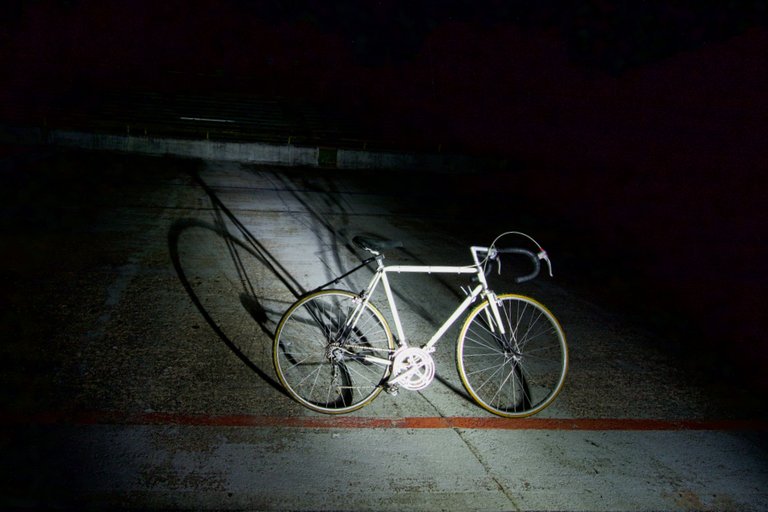Hello HIVEs!
You can find the previous two posts under the following links:
Die beiden vorhergehenden Posts findest du unter folgenden Links:

Canon EOS 6D Mark II
Laowa 12 mm F 2.8 zero-d
ISO400, 12mm, ƒ5.6, 124s
The cover photo was created in collaboration with @gunnarheilmann.
I called it cardio. Somehow I always combine cycling with cardio training. 🚴♂️💓
In order not to give myself a crooked back when realizing the image idea, I mounted a flashlight with a blue color filter and an aperture on a tripod rod with a clamp. This meant I was able to carry out the painting work on the racetrack while walking upright. As soon as I left the camera's recording range, Gunnar began illuminating the scene with a flashlight.

Canon EOS 6D Mark II
EF16-35mm ƒ4L IS USM
ISO250, 35mm, ƒ5.6, 53s

Canon EOS 6D Mark II
EF16-35mm ƒ4L IS USM
ISO250, 28 mm, ƒ5.6, 17s
After I discussed racing in the last posts, today I would like to briefly describe the architecture of the racetrack in addition to the light painting:
The project was planned by the renowned architect and ex-racing driver Clemens Schürmann.
Groundbreaking took place in October 1950 and the inaugural race took place on June 14, 1953.
The 333.3m long track was built without longitudinal or transverse joints. The seamless prestressed concrete technology was realized through a sophisticated construction of a steel skeleton. This promised good driving comfort and new speed records. Even today, the Bielefeld cycle track is one of the fastest tracks in the world.
The curves have an inclination of over 46°. The track is surrounded by stands that rise six meters above the interior. The stands offered space for 9,000 standing and 6,000 seated. A floodlight system ensured sufficient lighting for evening and night events.
Today the cycle track is one of the monuments of the city of Bielefeld and is preserved by the support association founded in 2014.
Geplant wurde das Projekt vom renommierten Architekten und Ex-Rennfahrer Clemens Schürmann.
Der erste Spatenstich erfolgte im Oktober 1950 und das Eröffnungsrennen fand am 14. Juni 1953 statt.
Die 333,3m lange Bahn wurde ohne Längs- und Querfugen gebaut. Die fugenlose Spannbetontechnik wurde durch eine anspruchsvolle Konstruktion eines stählernen Skeletts realisiert. Dadurch versprach man sich einen guten Fahrkomfort und neue Geschwindigkeitsrekorde. Noch heute zählt die Radrennbahn Bielefeld zu den schnellsten Bahnen Weltweit.
Die Kurven weisen eine Neigung von über 46° auf. Die Bahn ist von Tribünen umgeben, die sich sechs Meter über den Innenraum erheben. Die Tribünen boten Platz für 9.000 Steh- und 6.000 Sitzplätze. Eine Flutlichtanlage sorgte für ausreichende Beleuchtung bei Abend- und Nachtveranstaltungen.
Heute zählt die Radrennbahn zu den Denkmälern der Stadt Bielefeld und wird vom 2014 gegründeten Förderverein erhalten.
Gern kann auch für den Erhalt der Rennbahn gespendet werden...

Canon EOS 6D Mark II
Laowa 12 mm F 2.8 zero-d
ISO 100, 12mm, ƒ8, 9s

Canon EOS 6D Mark II
Laowa 12 mm F 2.8 zero-d
ISO 100, 12mm, ƒ8, 28s
Before we realized the cardio image, Hans, Gunnar and I experimented with the shadow of a racing bike. I had previously placed the bike on the racetrack using a tripod leg as support. Now it was a matter of finding a perspective in which the tripod was hidden by the bike. In the two pictures above you can see the support either as a shadow or directly on the seat post. It's often the little things that require a lot of patience from me. 🤨

v.l.n.r. Christian Dippel, Anette Fischer, Hermann Heidötting, Gerhard Dirkschnieder, Isa
Canon EOS 6D Mark II
EF16-35mm ƒ4L IS USM
ISO 100, 16 mm, ƒ8, 24s
In the picture above I show some of the club members in the tunnel that leads to the racetrack. Walking through the tunnel and then back into the light with a view of the racetrack creates a very special, heroic feeling. How must the athletes feel when they enter the racetrack with their bikes in front of full stands? Gunnar and I tried to express this feeling in the following picture.

Canon EOS 6D Mark II
EF16-35mm ƒ4L IS USM
ISO 100, 35mm, ƒ11, 24s
Model: Hans Roufflair
Hans was the model for this picture. Using a small fog machine I tried to fill the area behind the model with fog. I didn't really succeed because a constant draft of wind carried the mist out of the tunnel. Gunnar then set the kick light while I threw some light onto the model from the front with a flashlight.
I hope you enjoyed your trip to the velodrome and we'll see you again next Sunday here on HIVE. So stay tuned!
Ich hoffe, euch hat der Ausflug auf die Radrennbahn gefallen und wir sehen uns nächsten Sonntag hier auf HIVE wieder. Also bleibt dran!

Canon EOS 6D Mark II
EF16-35mm ƒ4L IS USM
ISO 250, 35mm, ƒ8, 28s
Model: Hans Roufflair
What Is Light Painting?

CandelART

WE ARE LIGHT PAINTERS

To help and support the LightPainters community here on Hive I would appreciate your delegation of HivePower. Any amount is appreciated. It does not require much to get started, we are happy for any gesture. @lightpainters
How to delegate?
Delegate 50HivePower, [50HP]
Delegate 250HivePower, [250HP]
Delegate 500HivePower, [500HP]
Delegate 1000HivePower, [1000HP]
All the Hive Power will help to upvote the artist's contribution as part of the LightPainters community.




